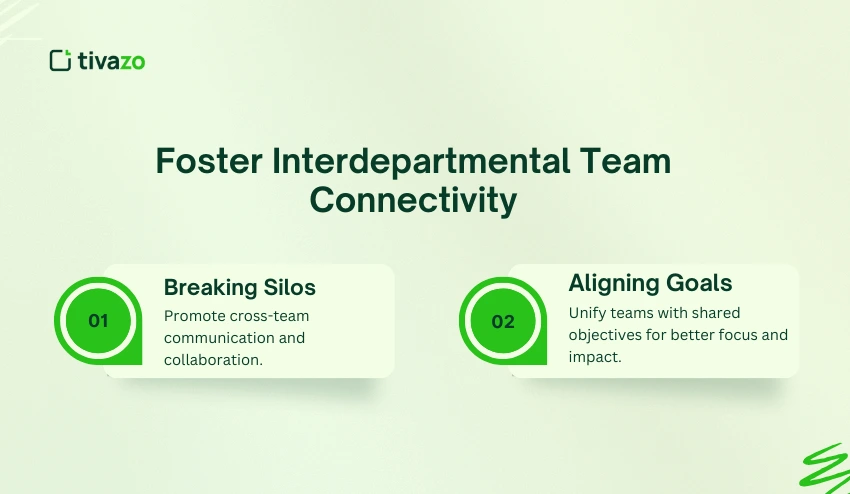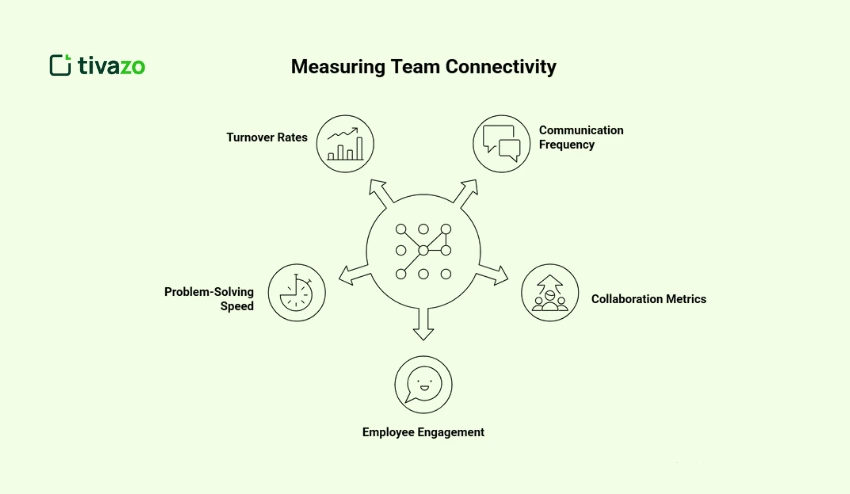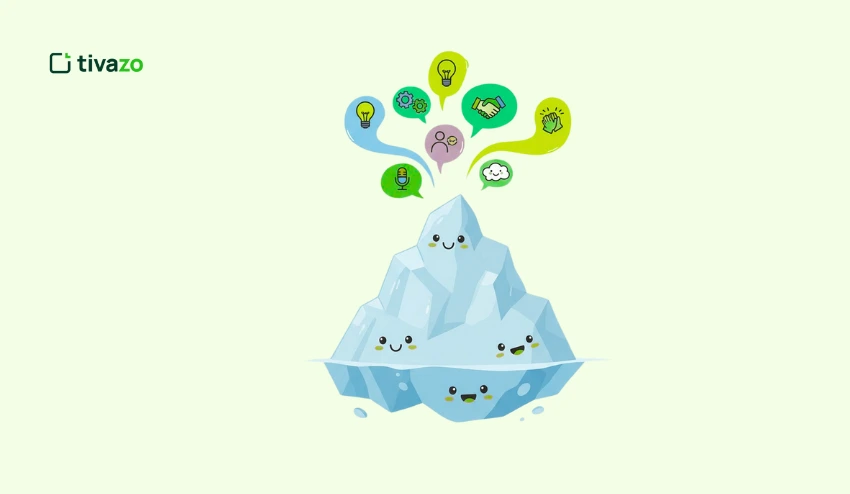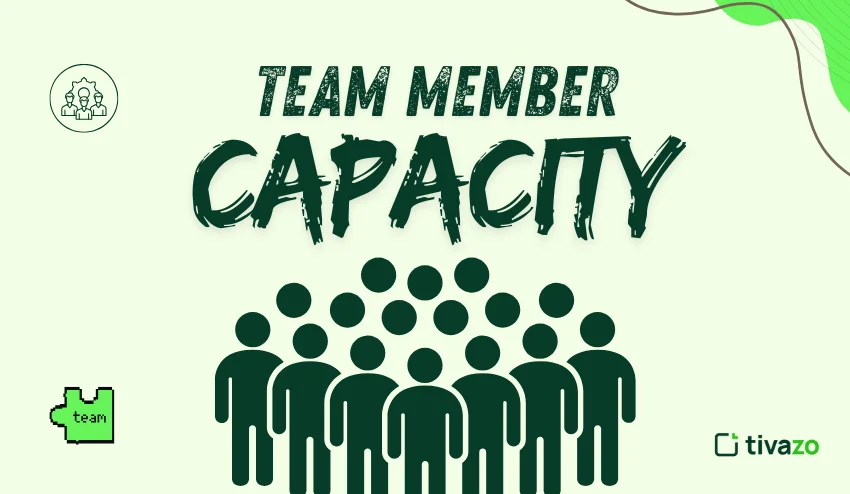If you believe that team connectivity consists of sending Slack messages or having Zoom meetings, you’re building a house of cards. The reality? Authentic connectivity is the competitive advantage of high-performing teams. The question is: how connected is your team?
Imagine a team where teamwork is seamless, ideas flow freely, and alignment is achieved regardless of time zones, remote or hybrid work, and different departments.
In this article, we’ll teach you how to apply 5 game-changing strategies that will change the way your team connects, collaborates, and achieves success. These strategies are not mere concepts; they are tried and true strategies that will transform the way your team works.
What is Team Connectivity
Let’s forget the old-school ideas of “just working together.” Team connectivity is about moving from collaboration to an ecosystem that enables your team to thrive. A connected team has flow, where ideas and action are unidirectional.
- This is about shared purpose, trust, and execution. The culture is one where the people genuinely care about each other’s success.
- A disconnected team? Maximum chaos. Some people may even be performing, but it has no cohesion. Team connectivity eliminates silos, opens communication, and creates collaboration at all levels.
Why Team Connectivity Drives Unmatched Success
In today’s working environment, team connectivity is mandated for any company that desires growth. Connectivity involves much more than efficient communication; it creates a force to move together where energy is being cohesively directed. When teams are authentic and connected, they are able to unlock and leverage their teammates’ potential, resulting in better solutions, innovation, and success.
The Real Impact on the Company:
- Quicker Problem Solving – Teams that communicate effectively give solutions faster.
- Less Wasted Time – Teams that connect do not need to email over and over again; they do not need to clarify their email or have misalignments.
- Innovative Collaboration – Connected teams can connect their ideas for innovative and breakthrough solutions.
- Greater Job Satisfaction – Employees who connect are more likely to stay, and to feel satisfied in their roles.
The Real Impact on Employees:
- Increased Skill: With constant communication and collaboration, employees have the opportunity to learn continuously.
- Career Learning: the connections lead to more visibility of contributions and therefore increase the pace of promotions. — especially when paired with structured development like PMP training that enhances project leadership capabilities
- Less Burnout – The shared accountability reduces the pressure on individuals because it becomes effective productivity.
5 High-Impact Strategies to Skyrocket Team Connectivity

1. Hyper-Targeted Communication Tools
When it comes to team communication, it’s not enough to select a tool; it’s about making the right and strategic selection that is aligned with the workflows and culture of your team. The smoother and effortless your communication, the more synergy you will experience as a team. One-size-fits-all tools rarely fit properly; what you really need is the right combination of tools that eliminate workflows and allow productivity.
- The Right Tool Matters: Slack could be for immediate chatting and communication, Asana is for tracking/watching/sending tasks, and Zoom is for face-to-face contact. But that’s not the end of it. Find tools that connect the dots, tools that support integration, sync across apps, and streamline processes.
- Action Tip: Use AI-enabled scheduling assistants like Calendly to simplify conversations around time zones, and use collaboration dashboards on Monday.com to promote transparency across the team.
2. Cultivate a Culture of Radical Transparency
Without trust, no team can be connected, and trust is built through transparency. Transparency is, quite simply, when nothing is not out in the open. Team goals, progress, challenges, etc., should all be visible and shared. If everyone has visibility across the board and knowledge of the team’s direction, everyone is more accountable and engaged to take action.
- The Transparency Principle: Employees should be aware of team goals, where they are in the project pipeline, and where they can improve.
- Action Tip: Utilize project timelines and performance dashboards for everyone to monitor what’s in progress and track the team’s direction.
3. Weekly Cross-Team Syncs with Clear Action Points
When teams work in a vacuum, inefficiencies, miscommunication, and missed opportunities are rampant. That’s when collaboration across teams is so important. Regularly syncing opportunities with other teams beyond the department is an essential practice to support a comprehensive approach to resolving issues.
- Purposeful Syncs: Gone are the useless, boring, long meetings. Each cross-team sync should have a purpose, and the entire team should have a set of actionable follow-ups. Collaboration is the goal; reporting is not.
- Action Tip: Implement a quickfire model for cross-team meetings, 5 minutes for updates and 10 minutes for cross-team brainstorming and resolving issues.
4. Data-Driven Feedback Loops for Continuous Improvement
Feedback is not merely an official review at the end of a quarter. Feedback should be continuous, actionable, and data-driven. Without a continuous loop of feedback, teams will inevitably plateau, or worse, regress. Infuse feedback into your team workflow – and, consequently, contribute to the creation of a workplace culture that embraces ongoing growth and improvement.
- Real-Time Feedback: Utilize platforms like 15Five to curate weekly feedback from your team on your leadership. Make real-time course corrections.
- Action Tip: Hold a monthly retrospective to collect anonymous feedback from team members about what is working, what is not working, and what can be improved upon.
5. Empower Remote Teams with Clear Ownership and Accountability
The largest limitation with remote teams is staying accountable without the constant presence of a physical office. Rather than using micromanagement (which diminishes trust and autonomy), empower team members with clear ownership of your initiatives and the autonomy to make decisions.
- Remote Leadership: Move away from overseeing every detail on every initiative to empower teams to make decisions, be accountable, and problem-solve.
- Action Tip: Use various goal-setting frameworks like OKRs (Objectives & Key Results) to ensure every team member has measurable objectives and direct accountability.
How Team Connectivity Drives Innovation & Creativity
When teams are connected, they don’t just work together, they create together. Team connectivity offers the strength of nurturing an environment of collaboration with fluid ideation. When individuals feel trusted, respected, and valued in a connected team, they are more likely to share their perspectives, contribute ideas, and try different approaches. This openness supports the establishment of real innovation.
The Power of Diverse Teams:
Innovation is not just new ideas, but also ideas drawn from a diversity of perspectives, likely to approach a problem in different ways. Connected teams bring viewpoints and approaches that lead to unexpected progress. When teams are made of members from different backgrounds, sets of skills, or departments, they contribute to the creation of a part of the puzzle.
A diverse set of ideas leads teams to creative solutions that would not surface in groups connected to less connected teammates or in isolation. When teams work together across departments, they are doing creative problem-solving together that would have been otherwise impossible if they didn’t work together.
Creative Synergy:
When multiple people connect, individual energy, knowledge, and experience are brought together and become intensified through their collaboration. When people are connected as a team, it is harder for them to work in isolation, and connected teams rely on them working together through creativity. Connected creativity enables individuals to build off the ideas of other individuals, leading to creation or innovation that is more significant than any individual could create on their own.
Collaborative creativity within a connected team enables them to create brave new ideas that unlock possibilities across the work they do and drive innovation across every project.
Action Tip:
Creativity and innovation can be engaged through the use of innovation sprints or hackathons. The innovation sprint encourages a cross-functional team with individuals from various departments or skill sets to come together and resolve real-world problems during the sprint’s timeframe. The goal is never just to innovate for the sake of innovating; it is to engage team members in a creative, action-based environment where all ideas are welcome.
Innovation sprints or hackathons disrupt silos and pod context within the sprint. It creates an environment of creative pressure through the short timeframe; teams are forced to produce ideas quickly, sometimes leading to breakthrough innovation.
How to Foster Interdepartmental Team Connectivity
Recommendations relate to developing this point about “departments as isolated islands” and the danger of collaborative relationships being limited to the department without the chance of ideas moving the company forward. Isolated departments mean no flow of creative solutions and limited room for innovation. To get the best performance out of companies, breaking down these barriers and silos into meaningful cross-functional teams, communication and cooperation can really help.

- Breaking the Silos:
- Interdepartmental communication is critical in creating a truly connected workforce. Encourage organization-wide knowledge sharing, joint projects, and team-building strategies between teams to break down these departmental walls. This is also helps to create a unified workforce that sees the bigger picture of how each unit operates, creating a joined effort that leads to collaboration across the organization.
- Aligning Team Goals:
- Have all teams aligned with the company’s objectives and vision. Shared goals allow all teams to focus on the end goals and not become distracted by different visions and executions. When all teams are on the same page, this helps alignment, simplifies procedures, and maximizes overall impact.
Navigating Remote Team Connectivity Challenges
The primary team connection challenge in today’s world is remote work. Keeping connections alive when people are not in the same room can be difficult at best. However, remote work should not have to hold strong value as an excuse; instead, we should use it to develop inventive solutions to enhance connections.
- Overcoming Distance:
- Utilize virtual whiteboards, video calls, and AI tools to connect teams from a distance. These media will help them work together in real time, regardless of their location in the world.
- Maintaining Human Connection:
- Schedule time for team members to engage and socialize outside of work context; use virtual coffee breaks or trivia for bonding opportunities to build more connections or engagement personally instead of professionally.
- Fostering Inclusivity Across Time Zones:
- Schedule meetings around multiple time zones to ensure everyone is involved and can participate, using tools like scheduling apps to facilitate finding overlapping times for meetings for global teams..
- Encouraging Asynchronous Communication:
- Use tools like emails or project management software to connect when team members are not on. This ensures the entire team stays updated, even though they are not working at the same time.
- Celebrating Remote Wins:
- Celebrate the small and big victories in virtual meetings or channels to continue to promote morale while also ensuring your team members feel acknowledged and recognized when working remotely.
How to Measure the Effectiveness of Team Connectivity
To assess if your team connectivity efforts are successful, you must have metrics you can measure. Count, evaluate and progress to ensure you are taking away the guesswork and actually improving. Here is how you can do that:

1. Communication Frequency and Quality:
Log how often the team is communicating with each other and the quality of the communication. Frequent, clear communication is usually a good sign of connectivity. Slack, Microsoft Teams, or email can show you both frequency and level of engagement.
2. Team Collaboration Metrics:
Count how often team members do extraneous collaboration on projects or contribute to team-based tasks. The more collaboration generally indicates better connectivity because these team members are typically willing to share ideas, resources, and knowledge.
3. Employee Engagement and Satisfaction:
Using one of the many engagement or feedback survey tools, ask employees about their engagement levels and their satisfaction with their team dynamics and each other. High levels of engagement typically mean that the teams and team members feel a sense of connectivity and bond with each other.
4. Problem-Solving Speed:
Did the teams solve the problems in a timely fashion? You can generally assume a connected team is quicker to solve issues since communication is often frequent and open, and there is plenty of trust with more effective decision-making and implementation of solutions.
5. Turnover and Retention Rates:
Monitor employee turnover and retention. Highly connected teams are less likely to experience high rates of employee turnover because individuals are happier with their work and enjoy working with their team.
9. The Future of Team Connectivity
AI and machine learning will change the future of team connectivity a focus on remote-friendly vs. just remote-first tooling and smarter team collaboration.
1. AI-Powered Collaboration Tools:
AI makes scheduling, task follow-up, and communication automation for more productive team connectivity.
2. Virtual and Augmented Reality (VR/AR):
VR and AR will form immersive, real-time virtual workspaces where teams can work together as though they were in the same room.
3. Integration of Communication Platforms:
Unified solutions will unify all communication tools to easily collaborate and keep context flowable through competing channels.
4. Remote-First Culture with Advanced Tools:
Dominated by stronger remote-first tools, teams will work without a hiccup, from anywhere, holding up strong levels of connected teamwork.
5. Real-Time Feedback and Analytics:
Meaning, live data and machine learning will arm teams with practical insights to enhance connectivity and performance and improve the application of collaboration.
6. Hyper-Personalized Team Experiences:
AI will personalize the experience of each team member to provide them with the right tools and support to collaborate.
Conclusion: Ignite Unstoppable Team Connectivity
The tactics above are not nice to have. They are crucial for recruiting a team that will succeed in the new world of business. And whether your hybrid situations are frustrating, your remote disconnections are wearing you down, the time to act is now.
It’s time to get control of your team’s connectivity. So, what’s the first strategy you are implementing? Let’s ignite that spark.




